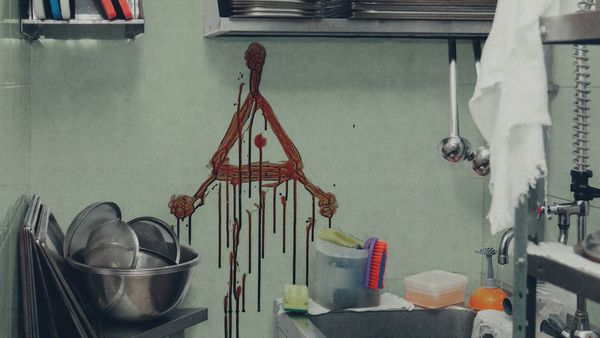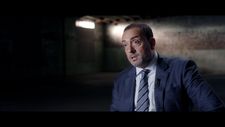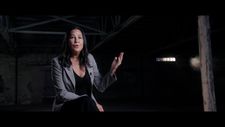 |
| Strange Harvest: Occult Murder In The Inland Empire Photo: Matthew M Garcia |
One of the more unusual films on the genre festival circuit this year, and one of the best, Strange Harvest: Occult Murder In The Inland Empire is styled as a true crime documentary whose chronicle of the pursuit of a serial killer takes in some unexpectedly strange phenomena. It’s a beautifully crafted work with a slow burn plot and little stylistic touches that elevate it above the genre it’s based on, without hampering believability. Shortly before its Fantastic Fest screening, I met director Stuart Ortiz and stars Peter Zizzo and Terri Apple, who play the investigating officers. Stuart told me how the idea originally developed.
“My first film is a film from 2011. It's called Grave Encounters, and it's like a found footage film,” says Stuart. “But in that movie we do have some documentary elements where we interview some people, and stuff like that. And ever since then, I thought it was a really cool approach to a horror film and just a different way that you could approach the story. So that was always in my mind, just that I like that format. And then it was during Covid in 2020 when Tiger King came out – Tiger King was this big phenomenon that's extremely popular. And, you know, Tiger King at its core – even though it has a lot of ridiculous other stuff – it's basically a true crime story.
“It just seemed like the timing was right and that true crime was at an absolute high point in terms of popularity. It all sort of swirled around. I was influenced by True Detective. I thought True Detective was brilliant in the way that it makes a police procedural with these other, supernatural elements. So that was a huge inspiration. I wanted to do a true crime doc, and it seemed like a serial killer would be the perfect subject for that. And then as it was me, I was going to inject some weird occult creepiness into it.”
“I just was fortunate enough to get the audition, which is the initial dream of any actor, to get an audition for a quality project,” says Peter. “This one, I got to read the script, and I'm a massive horror fan and also a massive true crime fan. So I was already in love with the script, which made me even more emotionally invested with the idea that maybe I could get this. But I absolutely saw myself in this guy. I got a sense that this guy was very haunted and – not that I'm haunted...” He pauses for a moment. “Well, we're all haunted.
“The guy was almost a musician, and I had almost a 30 year music career before I returned to acting, which is my other love. So there were a lot of cool coincidences about this thing. And so booking it and then befriending Stuart and learning how brilliant he was and how much of a concept he had figured out in his head was really a privilege for me.”
“I loved the acting,” says Terri. “I loved the work of it, you know? I love the character, and that's what drew me to it. I like great indie projects that are well done. I had not read the script. He's cheating,” she says, looking at Peter, and laughs. “I'm kidding. He got to read the script. I just loved her as a character. But at the same time, I was very nervous to do it because of the gore. And yet I had more fun on that and loved these guys, and it ended up being such a fabulous experience. The way he shot it was so brilliant. But I really resonate with the character and I just kept coming back to it and said, ‘I really freaking want to play Lexi Taylor, but I'm scared of it.’
“I like thrillers, but I don’t like gore, so I had two things going on, but I just kept going back to the character and wanting to play her and wanting this experience.”
Did the pseudo documentary format change the way he prepared for his role?
 |
| Peter Zizzo as Detective Joseph Kirby in Strange Harvest: Occult Murder In The Inland Empire Photo: Matthew M Garcia |
“Yeah,” says Peter. “One thing that was specified in the audition was that Stuart was looking for micro expressions. Obviously, with any actor, you want to believe in the circumstances, but with Stuart, the film was going to live or die based on whether or not you bought into the idea that this is a true crime documentary, or maybe you know it isn't, but you get lost in the fact that it is. And so for me, my training as an actor, which is mostly theatrical, allowed me to just pull it way back and just play inner things.
“That was the uniqueness of this challenge. I talked to a lot of actors about some of the hardest things about acting – things like ‘What do I do when the other person's talking?’ Suddenly you become much more conscious of your body and your face and your hands. And I think with this, it's almost that challenging, except you're the one that's talking the whole time, but you can't physically do very much otherwise it's going to look fake. Detectives are stone faced. They're used to horrific things. They’ve got a certain even-keelness about them. And so that, ironically, becomes the challenge: to do as little as possible.”
Talking about the style of the film, I tell Stuart how much I loved the shots of freeways, seen from above, at the start and end of the film. They have a Seventies thriller quality about them which perfectly suits the mood of the film.
“We went out to San Bernardino where the film is set, and we spent a couple days and shot this drone stuff,” he tells me. “As soon as I started looking at it, I was just like, ‘There's something really powerful and haunting about these shots of the real freeway.’ I can't remember what those two freeways are, but they're the major intersection in San Bernardino. Those images, as soon as I saw them and started putting them, I was like, ‘This has got to start the movie.’ And then I wasn't too long into the edit when I was like, ‘I want to bookend with this, too.’ There's something there. There's a haunting quality to this.”
“It's Lynchian,” suggests Peter.
“It's very Lynchian,” Stuart agrees. “I think it leaves you with the question of more questions than answers, which is exactly how I wanted to leave things.”
It leaves one wondering where all the people in the cars are going and what they’re doing, Peter says.
“Right,” says Stuart. “And there's like a million other stories that are out there and we're just telling this one.”
There’s a reference to the number of serial killers active in the US at any given time...
“I think everyone, even if they're not into serial killers or true crime, everyone just by osmosis knows about all the big heavy hitters, the Ted Bundys and the Dahmers, and people have heard all of these stories,” Stuart says. “It all just seeps in. As far as personal inspirations go, I think it was just a conglomeration. I've talked about Berkowitz, who was Son of Sam, he was a killer. And this other guy, Herbert Mullen, who claimed if he didn't kill people, there were going to be earthquakes that were going to destroy California. Both those guys were killing for, in their minds, some sort of higher purpose. That's the closest I can get with our guy, that he believed that he had this higher purpose that he had found.”
That higher purpose, and it various trappings, were influenced by the work of HP Lovecraft more than anything else, he explains.
“I'm a huge Lovecraft fan, a huge cosmic horror fan. So there's all sorts of little somewhat obscure references here and there, buried throughout. I think Strange Harvest is probably a conglomeration of Lovecraft, some Lynch, obviously, some Stephen King, and I don't know if it's in there or not, but there's a book called House Of Leaves that is one of the greatest contemporary horror novels we have that we're going to get. That's just an amazing, brilliant thing. And I don't know if it's a haunted house story. I don't know if it's totally comparable, but its version of uncanny horror that's very based in reality was a huge inspiration to me as well.”
 |
| Terri Apple as Detective Lexi Taylor in Strange Harvest: Occult Murder In The Inland Empire Photo: Matthew M Garcia |
Going back to Terri, I ask if the scenes that she worried about worked as she expected when she actually got on set.
“No, it was more detailed than I expected,” she says. “I knew part of my hesitancy was, ‘Terri, you're going to have to be on set doing this. One aspect is your acting, but then you're going to be on actual set.’
“I loved it once I did it. I was really scared but excited about going too, when it was the scene with the couple at the dining room table and everything, because I wasn't sure I would be able to handle it. I really wasn't. But as an actor and as the character, I had to handle it. Lexi Taylor is not scared of this stuff. Lexi Taylor has a passion to help these people. I think it always unsettles her stomach. It's certainly not something she enjoys, but the passion of solving this and getting details. I find her to be very detail-oriented, and so I picked parts of myself that fit that.
“Being at the pool with the leeches, I wasn't sure how that was going to play out either. I don't want to give anything away in the movie, but everything plays for real, and it helped the character. It was both a challenge and something that actually helped create the character and what I wanted to do with her.”
I ask Peter if he faced any big challenges like that.
“The amount of lines to learn?” he offers, laughing. “No. Because Terri and I are essentially playing the narrators of the story. And so I think for me, it's, you know, how do I convey the horror that this character has experienced and internalised without it being boring, flat? And so then it becomes the cadences and what the music is that you find in the cadences. We were the heroes. We've absorbed things that most people could never handle. And now we're telling you that story, and we contain the multitudes of horror that we have seen. Again, a unique challenge for an actor.
“It's sort of the kind of thing where Terri’s and my performances, I think, fit so beautifully into what Stuart created that someone who's not an actor might take for granted the challenges of playing a role like that. Unfortunately, when they filmed the leeches in the pool, I couldn't be there on that particular day, so Terri had to go it alone. I'm really bummed that I didn't get to see.”
“I know,” says Terri. “I was going to say, because we relished any scenes that we had together. The way Stuart set it up was you were watching in real time these moments. And when Peter and I played together as actors with these moments, there was so much. It was great. I don't want to give any scenes away, but we really revelled in the way that Stuart had the shots set up and the scenes and what we were seeing, and allowed us to explore and really create reality with those.”
“The documentary format everything for this story,” Stuart says. “Because this story is all about hinting at this larger supernatural, uncanny thing that may be going on. But because we're limited by the viewpoint of the documentary, which just by its nature can't explore every single thread, it can't go down every rabbit hole. It's limited to kind of the story it's trying to tell. That was everything. I think it's a great format for trying to do any kind of story that has any cosmic horror. Anything that's esoteric or uncanny or supernatural or otherworldly is great for a documentary format because you can ground it reality in a way that you just can't normally do in other horror movies. I haven't seen it utilised that way very much, so it was an exciting opportunity.”





















